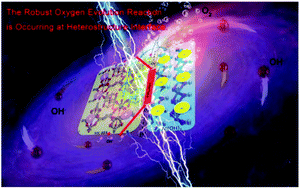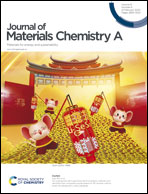Interfacial electron transfer of heterostructured MIL-88A/Ni(OH)2 enhances the oxygen evolution reaction in alkaline solutions†
Abstract
Developing earth-abundant, efficient and durable electrocatalysts for the oxygen evolution reaction (OER) is of great significance for sustainable energy storage and conversion devices such as water splitting devices and metal air batteries. In this study, a MIL-88A/Ni(OH)2 heterostructure was directly grown on carbon cloth (denoted as MIL-88A/Ni(OH)2-CC) for the first time by using a generic two-step hydrothermal method. The results showed that using carbon cloth as a three-dimensional self-supporting electrode could improve the conductivity of the catalyst, while the edges of the Ni(OH)2 layer can provide abundant active sites to synergistically boost the OER performance with MIL-88A. Impressively, the as-prepared MIL-88A/Ni(OH)2-CC catalyst delivers a current density of 10 mA cm−2 at low overpotentials of 250 mV in 1 M KOH and 352 mV in 0.1 M KOH, exhibiting small Tafel slope values of 36.4 mV dec−1 in 1 M KOH and 46.1 mV dec−1 in 0.1 M KOH, respectively. The MIL-88A/Ni(OH)2-CC catalyst also demonstrates a long-lasting stability superior to that of the RuO2/CC catalyst for the OER. Such intriguing OER properties can be attributed to the unique heterostructure at the interface between MIL-88A and Ni(OH)2, while density functional theory calculations also confirm that OH− has a very low adsorption energy at the interface of the heterostructure.



 Please wait while we load your content...
Please wait while we load your content...